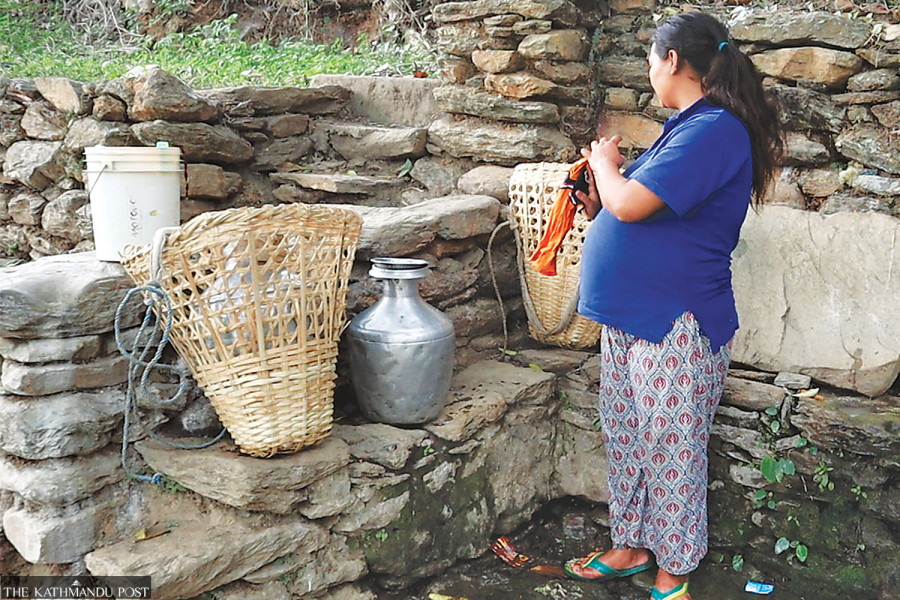National
Panchthar settlement struggles with acute water shortage as sources run dry
350 households affected. Locals blame unchecked road construction and use of heavy machinery for dwindling springs.
Laxmi Gautam
Sushmi Yokpangden, a 27-year-old woman from ward 7 of Hilihang Rural Municipality in Panchthar, is eight months pregnant. However, since April, she has had to make a half an hour journey on foot to the nearest spring in Chukphara to fetch drinking water. She has to make this trip at least thrice a day.
Yokpangden complains that it takes nearly an hour to bring back the water from Chukphara, which is down the hill from her residence.
“There are 350 households in ward 7 with a population of more than 1,000, and everybody is forced to bear similar hardship for drinking water. This problem arose after the Sanche stream dried up in April, resulting in the closure of the Sanchekhola Lift Drinking Water Project, the only project that supplies water in the ward,” said Yokpang.
The Sanchekhola Lift Drinking Water Project was started in 2012 to alleviate the problem of drinking water for locals of wards 6, 7, 8, and 9 of the then Bharpa Village Development Committee, which is currently ward 7 of Hilihang. The drinking water project was constructed at a cost of Rs300 million with the objective of supplying drinking water to 350 households.
According to the consumer committee of the project, water in the stream started depleting in February and it completely dried up in mid-April, resulting in the complete shutdown of the project. There is no river or stream nearby to restart the project, and almost all the natural springs have dried up. The few that are left are also beginning to dry up.
Rukmaya Rai, an 80-year-old woman from ward 7 of Hilihang, said that before the operation of the drinking water project, there were plenty of natural springs and small wells in the area, but in a decade, most of them have dried up.
“I have never experienced such a severe shortage of water in my lifetime here, even though Bharpa is a dry, hilly area. Now I am forced to travel up and down the hill for hours to fetch water in a pot and a couple of jars,” said Rai. “Some locals in other settlements even walk for two hours to reach the nearest spring. There are only one or two running springs in the area,” Rai added.
A road upgrade and widening has been going on for the last one year from Jorpokhari to Ektine Memeng, which is 250 metres away from the main source of the Sanchekhola Lift Drinking Water Project located in ward 1 of Phalelung Rural Municipality of the district, and locals claim that the natural springs, small wells, and streams dried up due to the use of heavy machinery such as excavators, bulldozers, and rock cutting machines.
The settlement in ward 7 of Hilihang is around eight kilometres from the construction site.
According to Tilbikram Idingo, chairman of the consumers’ committee and senior technician of the lift drinking water project, shock waves and vibrations generated by heavy machinery in the hills and mountains cause more damage to the water sources.
“We have not been able to conduct any study or research regarding the use of heavy machinery on the construction site, but the issue of springs and small wells drying up began when the road upgrade and widening work started. The water level of the Sanche stream started decreasing, and the water became murky from the last rainy season. And there is no water in the stream this time,” said Idingo. “The stream has not changed its course but has completely dried up, which was the only source of water for several settlements. Local units cannot conduct detailed research without the help of provincial authorities,” Idingo added.
Since the source of the lift drinking water project dried up in April, efforts have been made by the consumers’ committee to ensure that water reaches household taps. They used fire engines and tankers to fill the project tanks. The neighbouring Phidim Municipality provided a fire engine free of cost for the purpose, while Hilihang Rural Municipality has arranged a tanker and is covering the fuel costs.
Ramkumar Majhi, a ward member and local resident of ward 7 of Hilihang, said that 9,000 litres of water is being transported daily from the Hewa stream, which is 25 kilometres from the source of the project. Large vehicles cannot reach the settlements in ward 7 due to the difficult topography.
“Water is being supplied to consumers twice a week, and every household gets 20 litres of water each time. A small family of four is also having difficulties surviving with just 20 litres of water for three to four days,” said Majhi.
Samar Bahadur Adhikari, chairman of Hilihang Rural Municipality, said that they cannot continue transporting water for much longer due to the hefty daily cost Rs20,000 on fuel alone.
“The water crisis continues until monsoon rains begin because the stream is completely dry. We are planning to ask the provincial government to help find alternative solutions for drinking water,” said Adhikari.
Similarly in Rautahat, several streams in the northern hilly region of the Chure range have also dried up this year.
Shailendra Mishra, chief of the Rautahat Division Forest Office, said that due to human encroachment, illegal excavations, and mining in the Chure region, most of the streams in the hilly areas in the north have dried up.
“The streams of Gaidatar, Dhiyal, Khayaku, Morange, Chisapani, and Siran in the north, along with other streams in the nearby areas, have completely dried up. Several other streams are also on the verge of drying up before the rainy season,” said Misra.




 16.12°C Kathmandu
16.12°C Kathmandu












